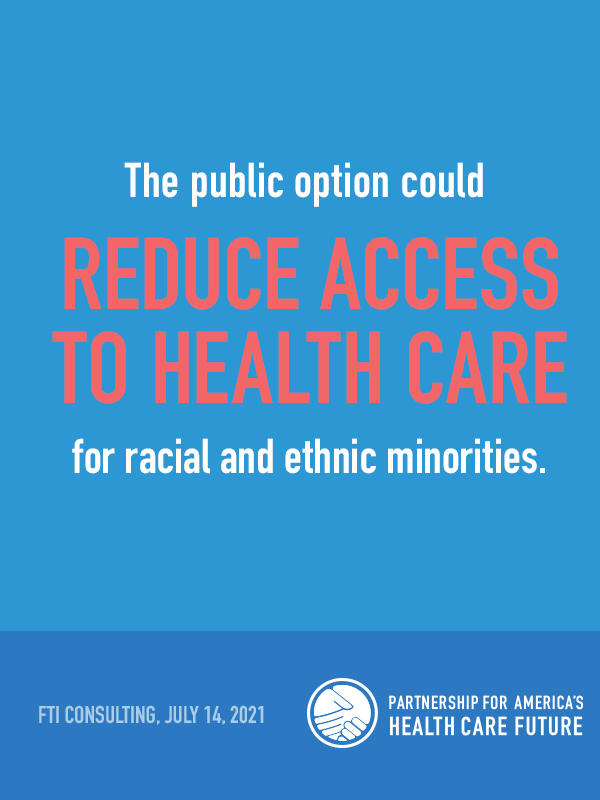New Report: The Public Option Could Worsen Health Disparities, Produce Minimal Coverage Gains

WASHINGTON – As some federal lawmakers consider creating a new government-controlled health insurance system known as the public option, a new report by researchers at FTI Consulting finds that doing so could come with negative consequences for patients in underserved communities, including racial and ethnic minorities and rural residents.
The report, which was supported by the Partnership for America’s Health Care Future, warns that these populations could disproportionately experience reduced access to health care services as a consequence of lower reimbursement rates to already struggling hospitals. At the same time, the report finds creating the public option could result in minimal coverage gains, reducing the national uninsured rate by a mere 0.7 percentage points.
Key findings of FTI Consulting’s report, “Ripple Effects: Potential Impacts of a National Public Option on Provider Viability and Disparities in Access to Care,” include:
The Public Option Could Produce Minimal Coverage Gains While Putting Patients & Providers At Risk:
- While the public option aims to expand access to health care coverage, coverage gains under the proposal are likely to be limited, reducing the overall national uninsured rate by only 0.7 percentage points.
- More than 1.5 million currently insured individuals will likely forgo private insurance under the proposal, shifting more of the U.S. population into government-controlled health insurance systems.
- By increasing the number of individuals with government coverage characterized by low reimbursement rates, the public option could lead to more financial challenges for health care providers. Of the hospitals in the report’s sample, approximately half would suffer financial losses due to the public option, totaling $1.3 billion annually.
- More than 500 of these hospitals are already operating at a significant loss and would be at higher risk of financial distress under a public option.
- These higher-risk hospitals could be forced to reduce service lines, shorten appointment times, or implement staffing changes to make up for lost revenue, thereby diminishing access to essential health care services for patients.
The Public Option Could Worsen Health Disparities For Communities Of Color:
- Almost one-third of the hospitals at higher risk under the public option serve communities where racial and ethnic minority patients are overrepresented and for whom barriers such as lack of reliable transportation may limit access to alternative sources of care.
- Hospitals that serve disproportionately diverse patient populations could lose a combined $45.8 million annually under the public option. Compounding the magnitude of this loss, approximately one quarter of these hospitals are the sole hospital in their county.
- Black and Hispanic Americans experience worse health outcomes and more barriers to care compared to their white counterparts, meaning service line disruptions or hospital closures in racial and ethnic minority communities could be particularly catastrophic for these populations.
- Many of the hospitals at financial risk under the public option are located in the Southwest, home to disproportionately large Hispanic populations. Hospitals in Arizona, Texas and New Mexico would lose nearly $18.4 million per year in combined revenue as well.
- In Texas alone, eight hospitals that are the sole source of hospital care in predominantly Hispanic communities would be at higher risk of closure under the public option.
- Hospitals in large population centers in states such as Illinois and New York could be disproportionately affected by the proposed public option.
- Fifty percent of hospitals in Kings County (Brooklyn), New York – home to neighborhoods which count fewer hospital beds than necessary to serve the population – would be at higher risk.
- Similarly, community advocates in the South Side of Chicago warned that a hospital closure could further strain the community’s already overburdened health system; yet nearly one-third of hospitals in Cook County could be at risk under the proposal.
The Public Option Could Put Rural Hospitals & Patients At Greater Risk:
- The public option could decrease access to care in rural communities by putting one in four rural hospitals at increased risk of financial distress. Of the higher-risk rural hospitals in the sample, 90 percent were the only hospital in their county.
- Given that many rural, low-income areas have a limited number of health care providers, losing even one hospital could have a dire impact on access to care.
FTI Consulting’s report comes as private plans and public programs are working together to expand access to affordable, high-quality health coverage and care. The U.S. Department of Health and Human Services (HHS) reports that nearly 31 million Americans have gained coverage under current law as of 2021, and more than one million consumers now have health coverage that costs $10 or less per month via the federal Health Insurance Marketplace. Meanwhile, research by the Commonwealth Fund shows adult uninsured rates and racial and ethnic coverage inequities have been lowered in almost every state over the past decade.
- To read FTI Consulting’s full report, “Ripple Effects: Potential Impacts of a National Public Option on Provider Viability and Disparities in Access to Care,” CLICK HERE.
- To learn more about the Partnership for America’s Health Care Future, CLICK HERE.